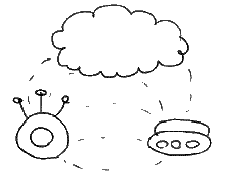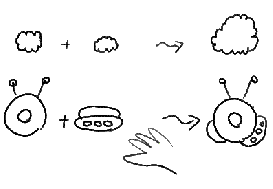Objective
2: Emerging Functionality
 The
functionality of an artefact corresponds to the range of functions
it exhibits or the experience it provides. In reality we may expect
a range of different kinds of artefacts, some general purpose and
some quite specific. The
functionality of an artefact corresponds to the range of functions
it exhibits or the experience it provides. In reality we may expect
a range of different kinds of artefacts, some general purpose and
some quite specific.
Even
if an individual artefact has limited functionality, it can have
more advanced behaviour when grouped with others. The aim is to
look at how collections of artefacts can be made to work together,
and in particular how they provide behaviour or functionality that
exceeds the sum of their
parts.
The
basis for new functionality to emerge is due to the fact that artefacts
have properties as described in the first objective, for instance:
- They
are Modular
- They
can Communicate with others
- They
can adapt and learn from previous events
- They
can be placed in various locations
These
properties lay the basis for collections of artefacts to be able
to behave as a complex interacting system. The main aim of this
objective to see how to take advantage of this inherent complexity
so as to allow for the behaviours and functionalities of collections
artefacts to be changeable and emergent.
Because
artefacts can be re-configured, or recombined by people and because
they can adapt and evolve, their collective behaviour is not static,
and collections of artefacts can evolve to produce new behaviours.
This is not just a random behaviour, but one that is guided by how
artefacts are used or configured by people.
As a consequence, people are given ‘things’ with which
to make ‘new things’, rather than only being supplying
with fixed and un-changeable tools. This requires a ‘re-think’
about the ways in which tools should be conceived of and designed,
and this is taken up further in objective
3.
In
order to lay the foundations for new functionality to emerge from
collections of artefacts, this objective considers two main topics:
Working
Together
Artefacts
have to be able to work together in order to allow new ‘collective’
functions to emerge. As a basis for this, research is needed into:
- The
ways in which artefacts communicate with other artefacts or other
information sources (either globally or locally) and the protocols
they should use.
- The
structuring of different kinds of artefacts into collections or
‘families’, each with a different role and level of
influence.
- The
design of new forms of ‘adaptive operating systems’
that would provide a platform for more general software across
a range of artefacts.
Emerging
Functionality
Given
that artefacts can communicate, adapt and are modular, the specific
ways in which functionality can be designed for collections of artefacts
have to be researched.
This
should consider the ways in which functionality can be constructed
and the specific ways or conditions for new functionality to emerge.
Some indications are outlined below:
- Because
artefacts are modular means that parts of them (either from the
software, hardware or physical aspects) can be constructed, deconstructed
or mixed, or added on to other artefacts. These kinds of changes
would in turn create a new hybrid artefact with a new functionality.
Combinations or various artefacts would lead to new functionality
that would go beyond what individual artefacts could do.
- The
fact that artefacts can communicate and can be aware of other
artefacts, means that under certain conditions, artefacts could
‘synergize’ to produce new properties and behaviour
that they otherwise they would not exhibit. For example, the proximity
of a group of artefacts could trigger an interaction between them
and a new functionality would become possible. This principle
‘non-linear addition’ or synergy could also be applied
to certain groups of artefacts interacting over a distance.
- The
fact that an artefact can learn or adapt from a history of past
events, means that this knowledge can trigger new functionality
that for example, emerges with time. An individually adaptive
artefact may also communicate with other adaptive artefacts so
that a group would produce a more complex behaviour.
|